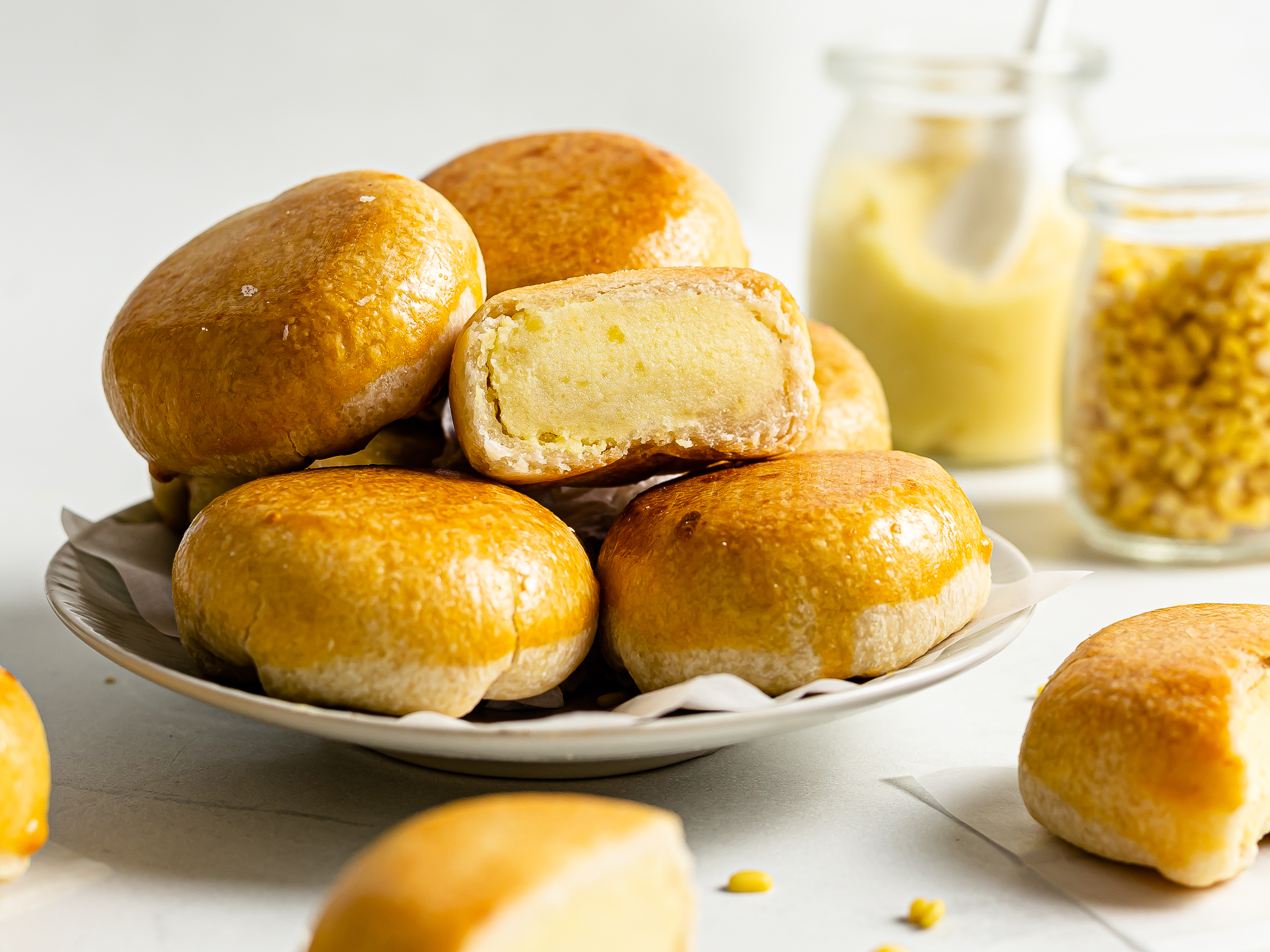Filipino mung bean hopias are small flaky cakes with sweet mung bean filling. Today, we'll show you how to prepare these pastries from scratch, filling and dough included! It's a recipe that requires a little work, but it'll be totally worth it. So, let's jump right into it!
Hopia cakes are a beloved Filippino sweet treat, but they actually have Chinese origins. The term hopia derives from the Chinese Hokkien word "ho-pia", which means "good pastry" and refers to a round pastry cake.
The most common fillings you can find in Filipino hopias include purple yam jam (known as ube halaya), sweet mung bean paste, and savoury wintermelon.
We made a hopia recipe with ube filling and absolutely loved it. So, we decided to give mung bean paste a try next!
Hopia made with mung bean paste is called hopiang munggo in Filipino. This flat cake has a sweet filling made from yellow mung beans and a flaky dough shell. It's crusty, friable, and full of flavour — so good!
For the sweet bean filling, you'll need yellow split mung beans, also called munggo or monggo dal, plus sugar, salt, and oil. To make the bean paste, you have to cook the pureed beans on a dry skillet until they turn into a dense paste, similar to cookie dough.
We show you how to do this in our sweet mung bean paste recipe. You can find all the instructions there, plus extra tips!
As for the dough, hopias usually have a flaky shell of pastry dough that resembles a shortcrust dough, but some variations can also come with a cake-like crust.
In our recipe, we used pastry dough, and we'll show you how to make it from scratch using just flour, oil, and water. No butter needed!
The hopia dough preparation follows the Chinese puff pastry method. First time hearing about it?
Chinese puff pastry is made by repeatedly folding and rolling out alternating layers of a "water dough" and "oil dough" to make a flaky and light crust.
The process is similar to the lamination in puff pastry for croissants, but it doesn't involve proving the dough as there's no yeast.
And instead of using butter for the fat layer, you'll use an "oil dough", a paste made with flour and oil that has the consistency of peanut butter.
Preparing the dough from scratch will take some time as you have to chill it between rounds of lamination. But your effort will be rewarded: you'll have ultra flaky hopia cakes with a delicious beany filling!
You'll love them!
Ingredients
| Filling | |
| Sweet Yellow Mung Bean Pasterecipe | 340 g |
| Oil Dough | |
| Plain All-Purpose Flour | 120 g |
| Salt | 1/4 tsp |
| Vegetable Oil | 80 mL |
| Water Dough | |
| Plain All-Purpose Flour | 180 g |
| Salt | 1/4 tsp |
| Sugar-Free Erythritol Sweetener (or sugar) | 1 tbsp |
| Vegetable Oil | 60 mL |
Step 1
For the hopia filling, use sweet mung bean paste.
You can make it from scratch using yellow split mung beans and following our sweet mung bean paste recipe.
It's super easy, and you need very few ingredients.
You can also use whole green mung beans as an alternative, but the paste will look darker and brownish-greenish.
The ready-made sweet bean paste filling is quite hard to find, but if you don't want to make it from scratch, you can try looking for it online or at your local Asian food store.
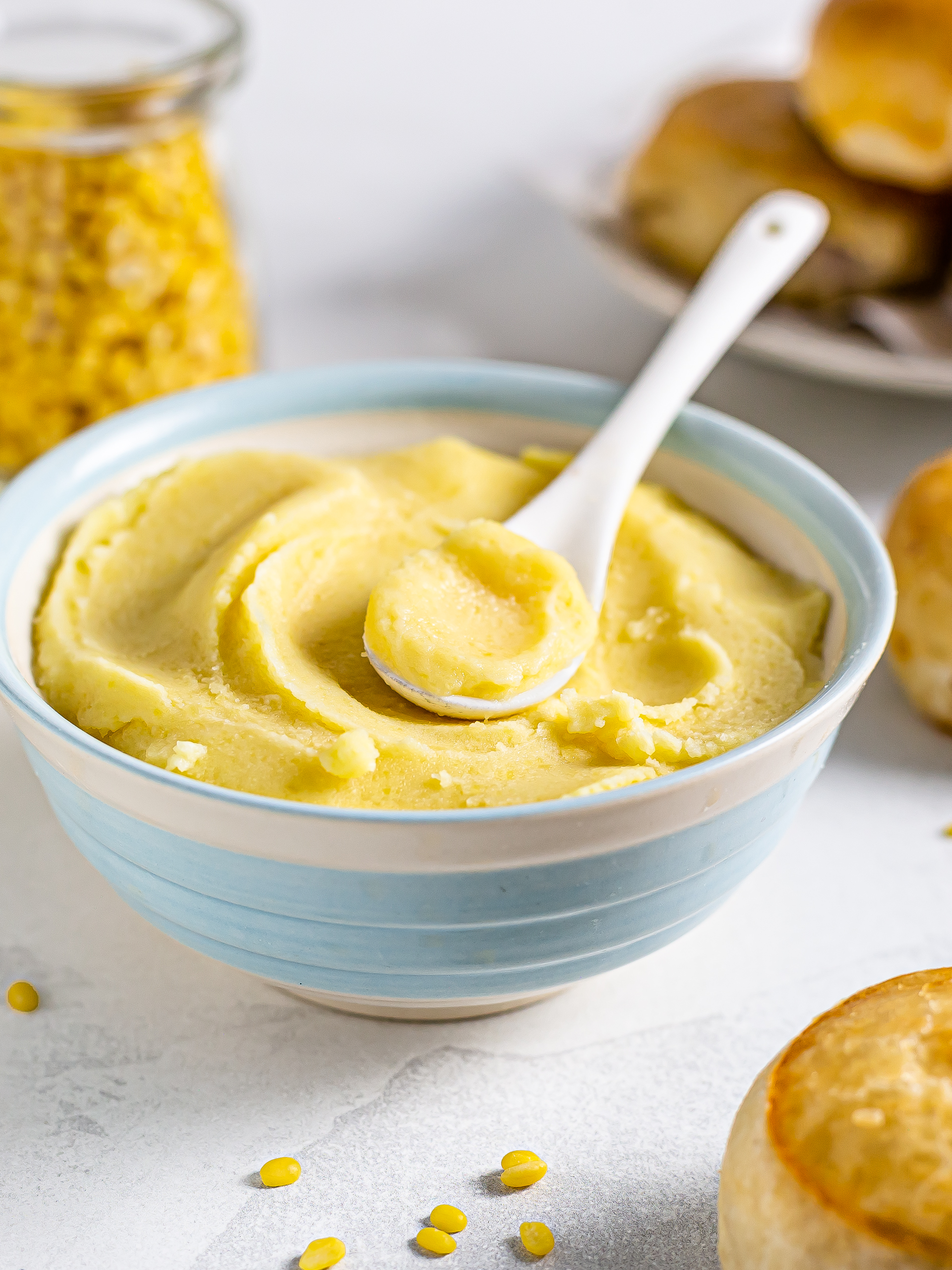
Step 2
For the hopia pastry, you'll prepare a "water dough" and an "oil dough" and then laminate them together to make a flaky pastry dough.
For the "water dough", mix sifted flour with salt and sugar (or erythritol sweetener) in a bowl.
Then, tip the oil and rub it into the flour with your fingertips until you have a crumbly dough (1).
Now, pour in the cold water and work all into a smooth and pliable dough, kneading it for a few minutes on your worktop (2).
Wrap the dough in cling film and let it chill in the fridge for 15 minutes.
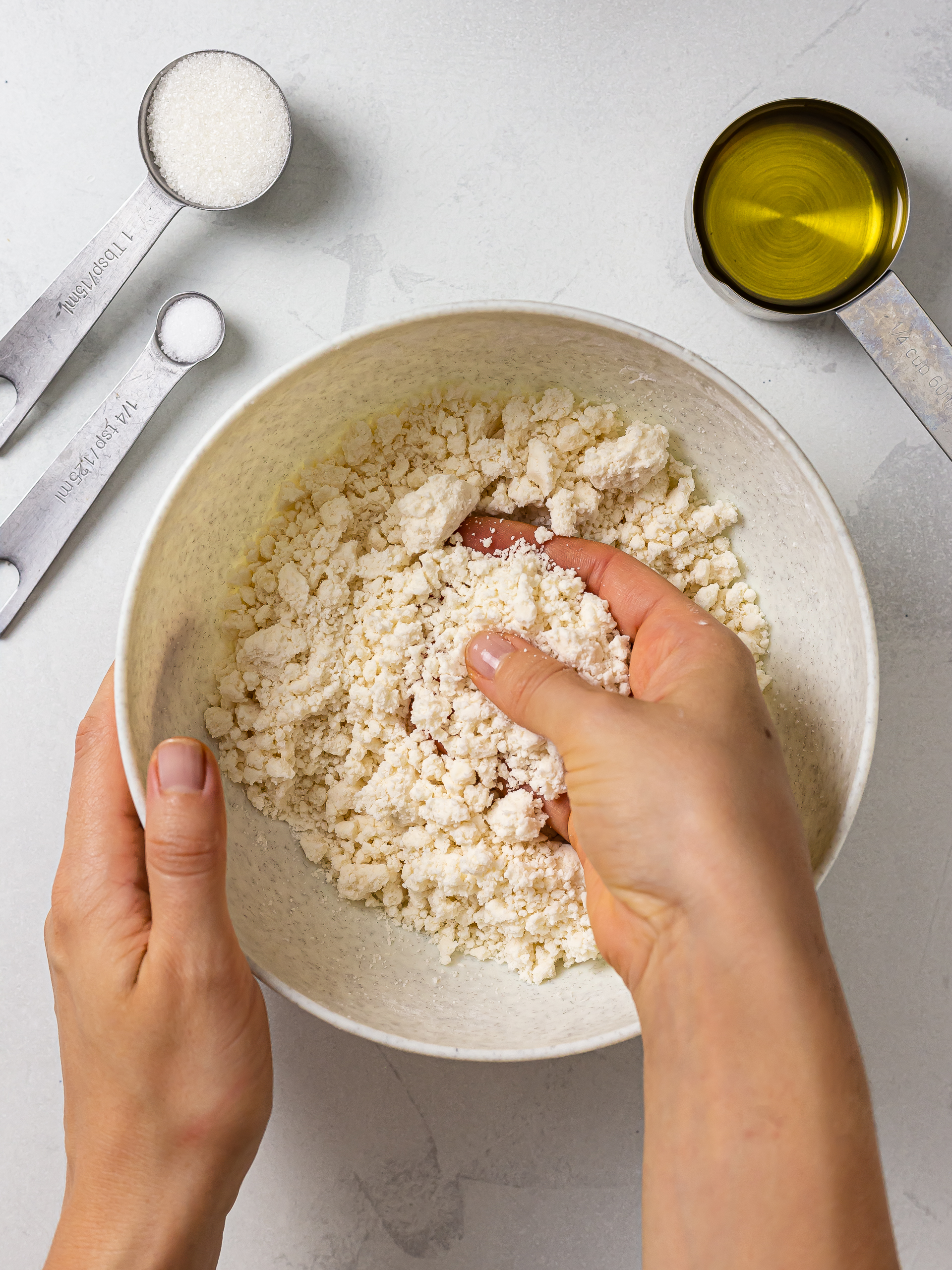
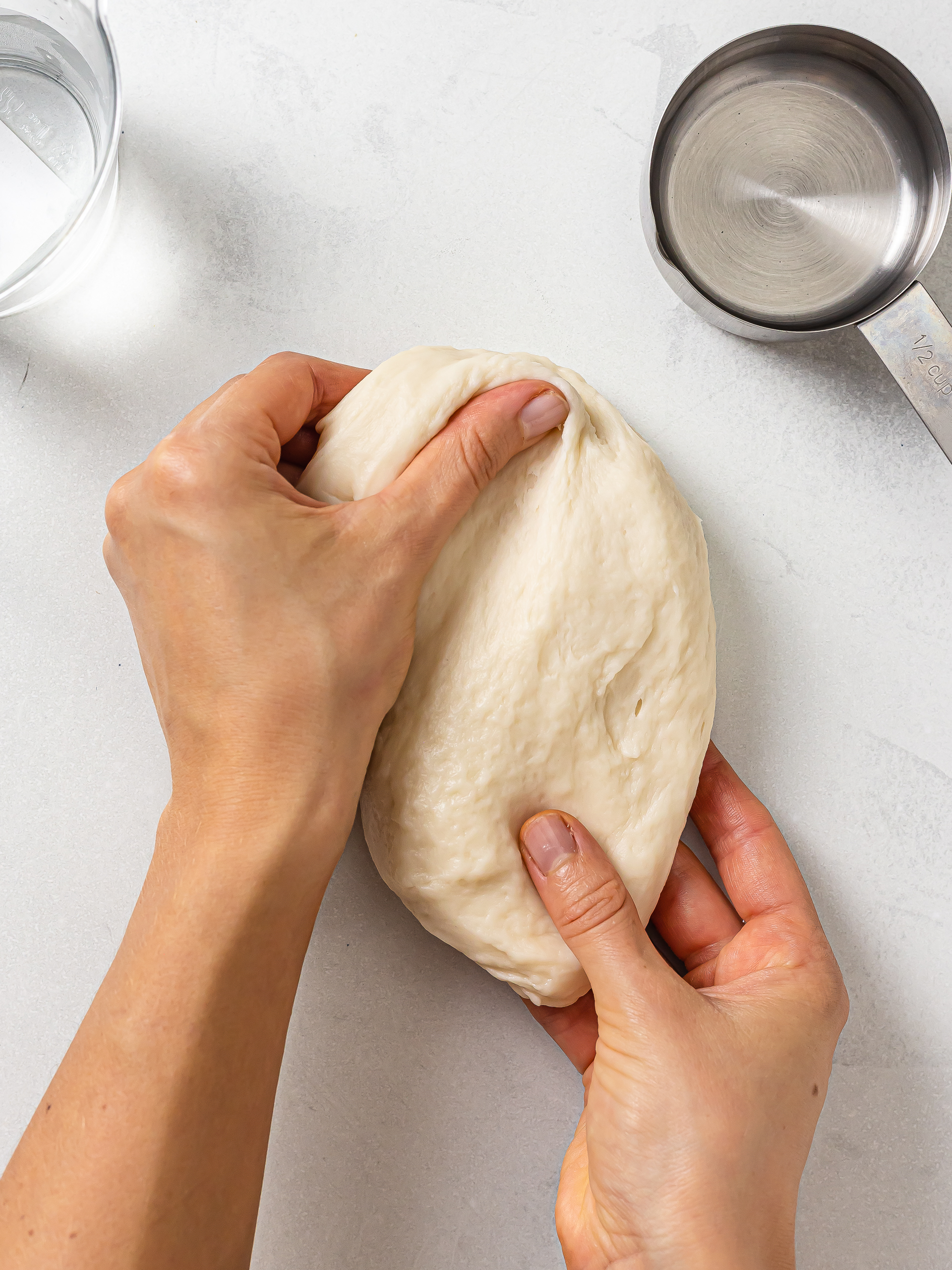
Step 3
For the "oil dough", mix flour with salt in a bowl and add the oil.
Stir well until you have a silky and slightly runny paste that looks like smooth peanut butter.
Cover the bowl with cling film and let the oil dough harden in the freezer for 10 minutes.
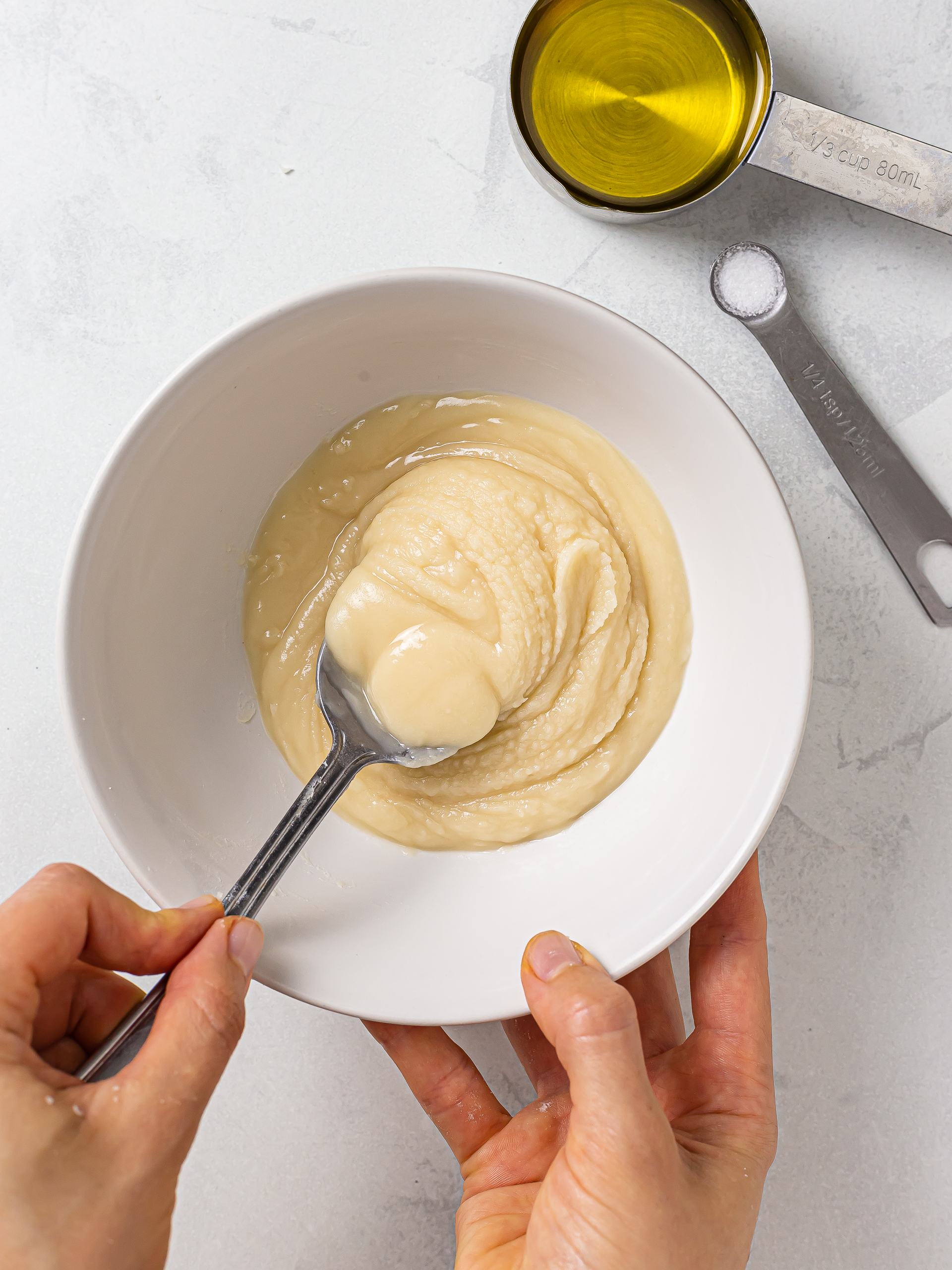
Step 4
For the first lamination, you want the "water dough" and "oil dough" to be as cold as possible, so they won't mix but rather stay as two separate layers.
Dust your worktop with a little flour.
Use a rolling pin to roll the "water dough" into a rectangle, about 5mm thick.
With the short side of the rectangle toward you, use a spatula to spread the "oil dough" over the bottom half of the dough, leaving a little space on the edges (1).
Then, fold the top half of the rectangle over the oil dough layer to cover it (2).
Seal the dough edges, pressing with your fingertips; this way, the oil dough won't ooze out when you roll out the dough in the next step.
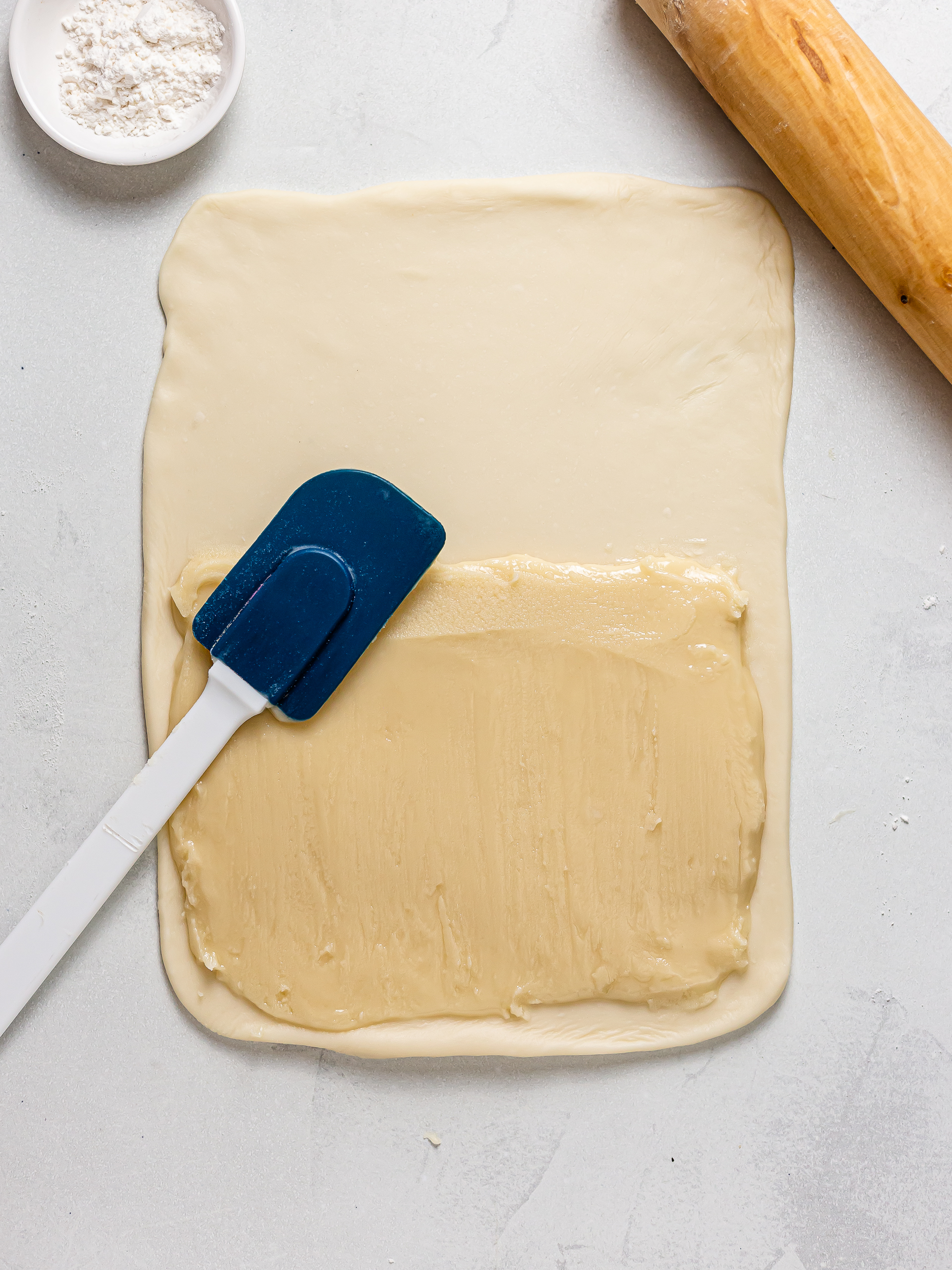
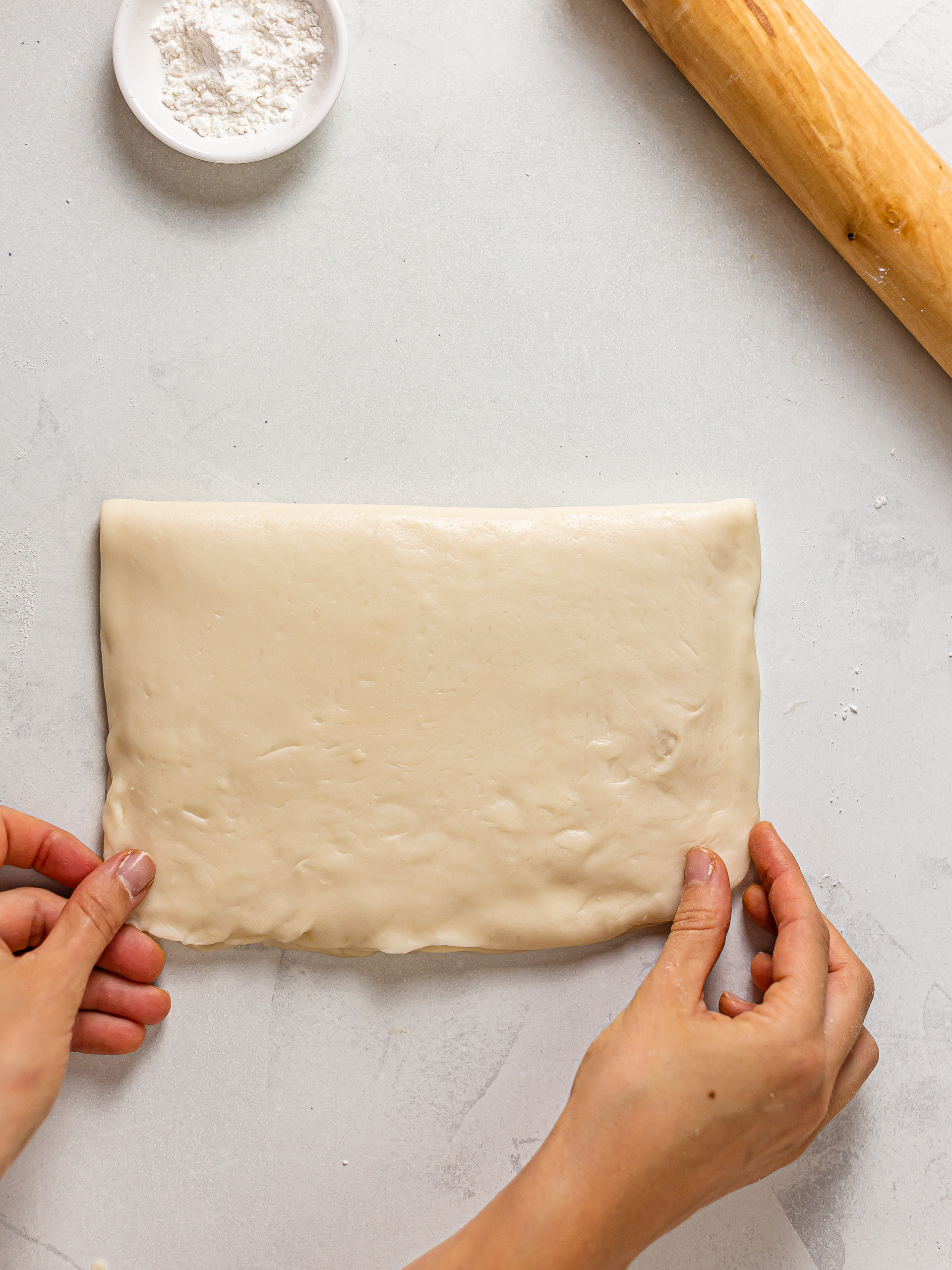
Step 5
Now, turn the folded dough by 90°, so the short side of the rectangle is toward you.
Use a rolling pin to roll the dough into a long rectangle about 3 mm thick.
Keep the short side of the rectangle toward you.
Fold the bottom 1/4 of the rectangle (1) and then the top 3/4 so that the dough ends meet (2).
Finally, dust off any flour with a pastry brush, and fold the dough onto itself, as you would close a book (3).
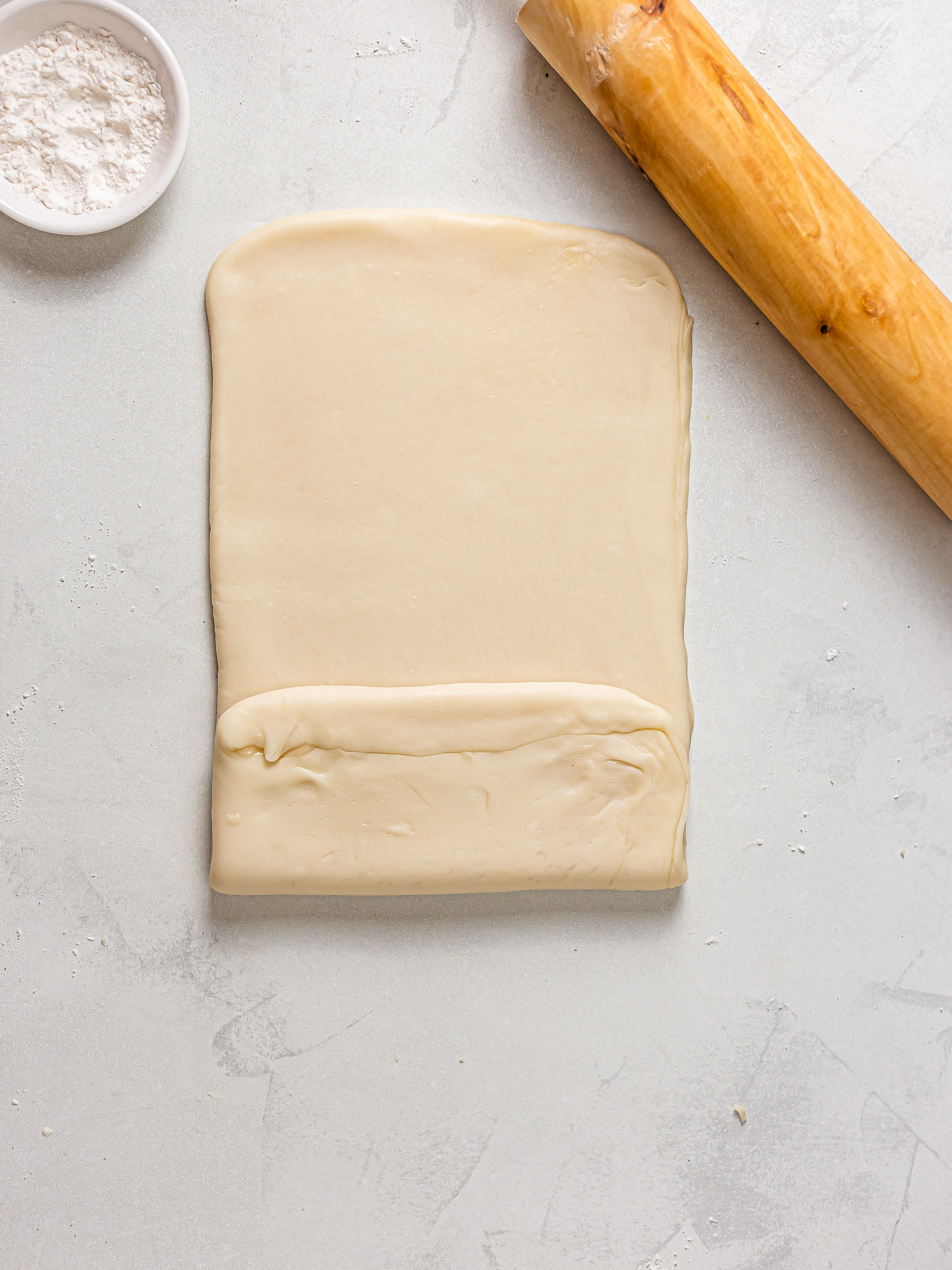
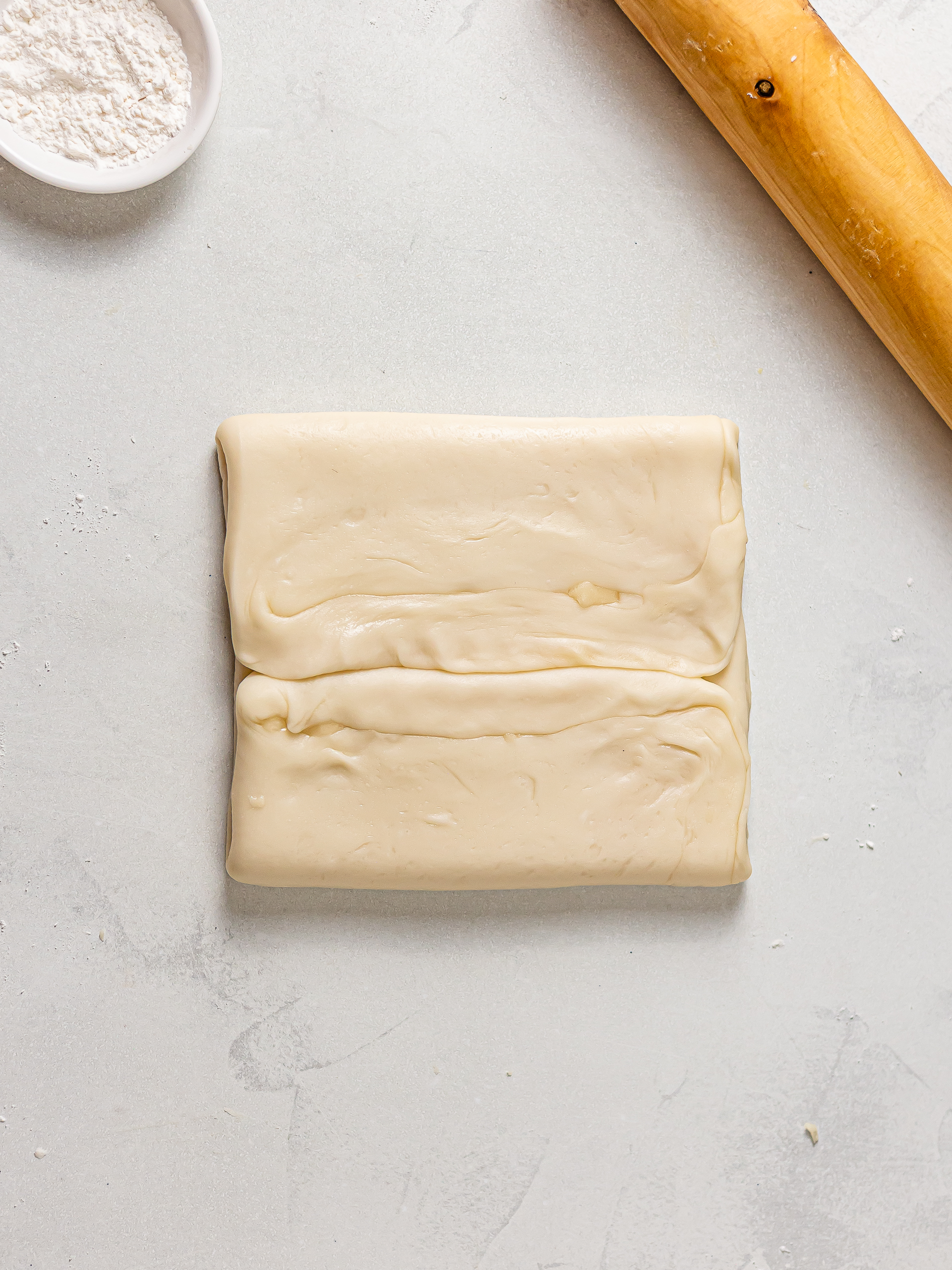
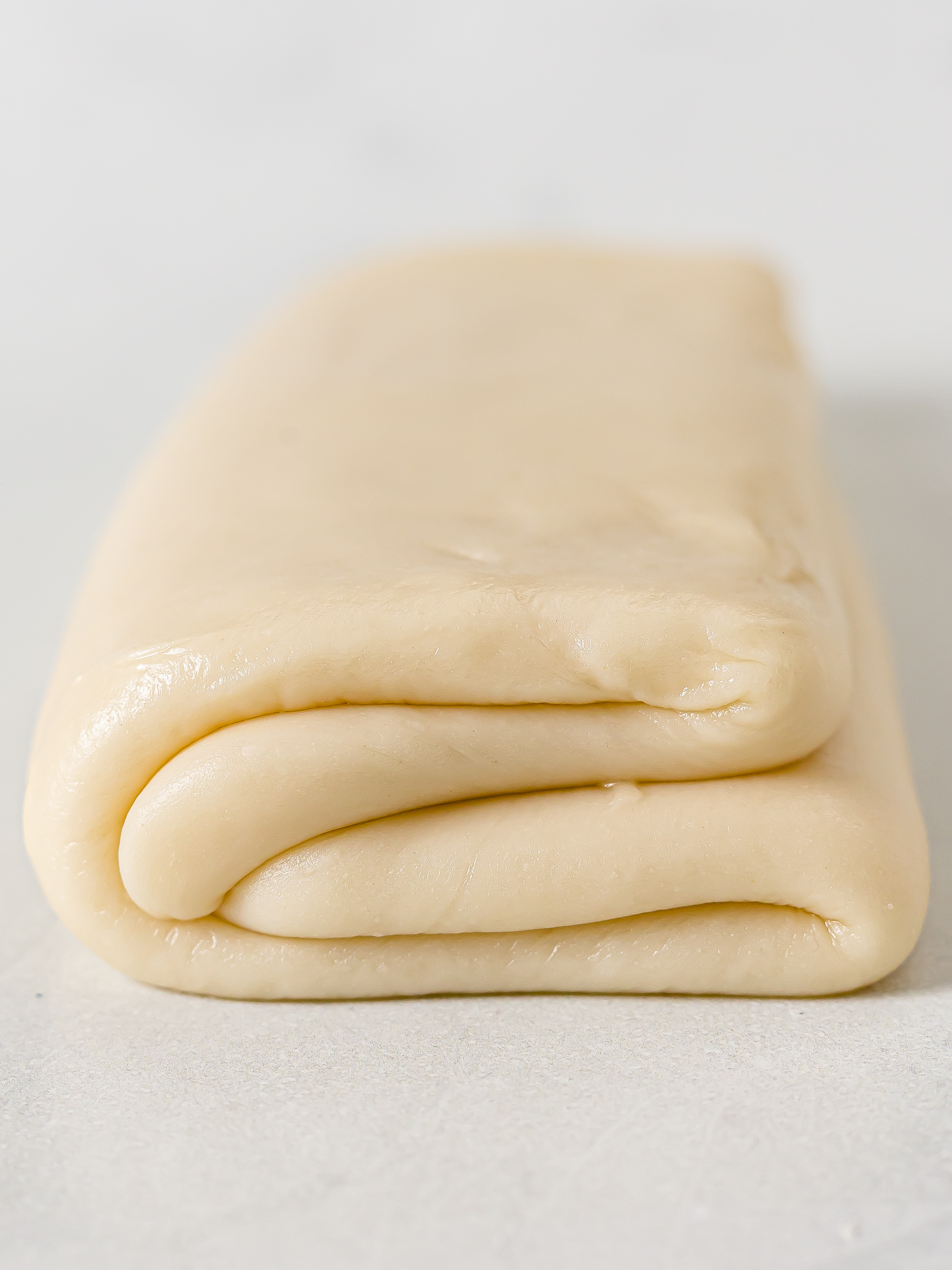
Step 6
Next, chill the dough.
Wrap the dough with cling film, place it on a tray or plate, and let it chill in the coldest part of your fridge for 40 minutes.
This step is important to let the oil and dough layers harden.
This way, they won't mix when you repeat the lamination process.
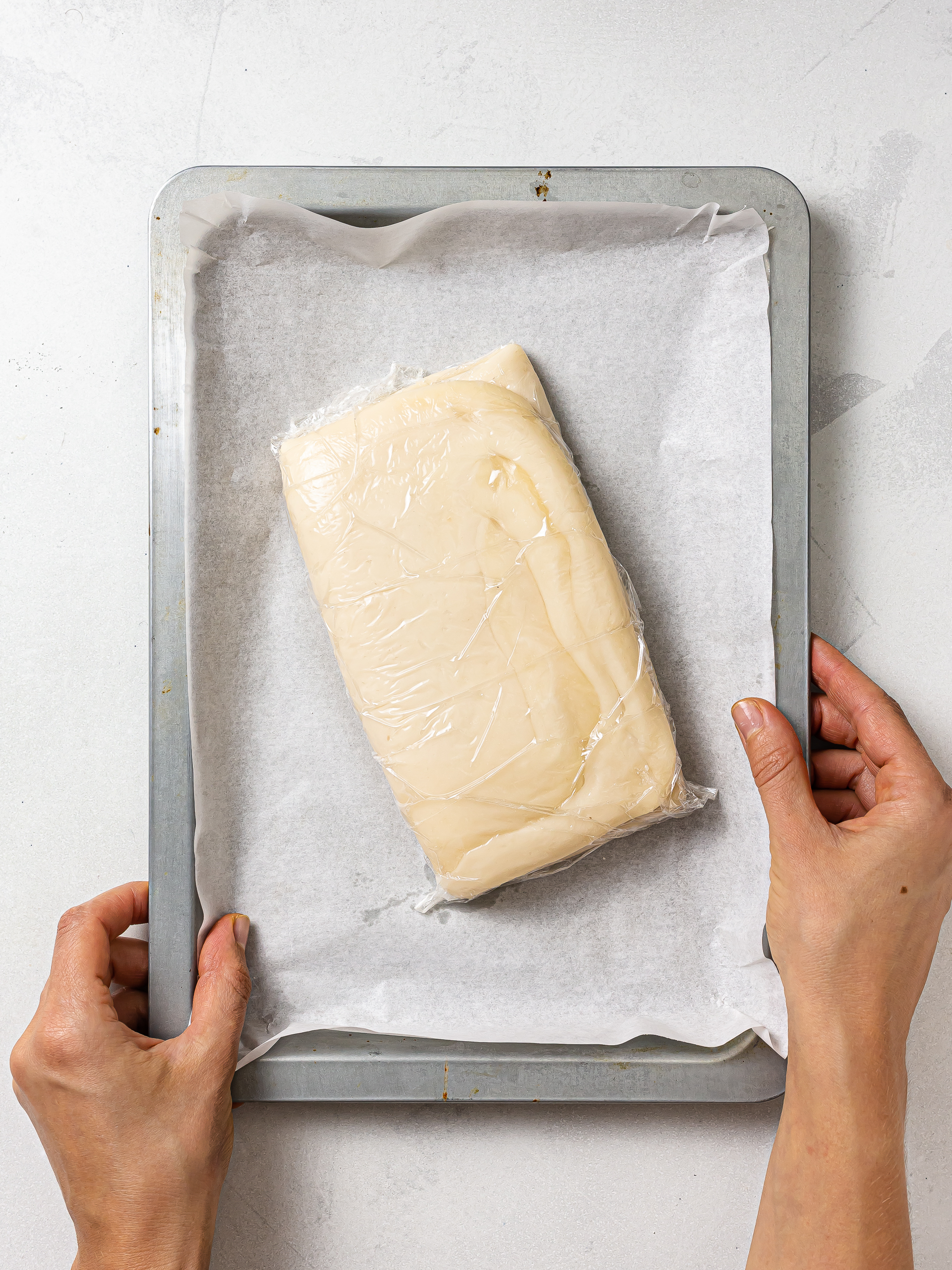
Step 7
Now, you'll have to repeat the lamination 2 more times.
Each time, take the dough out of the fridge, unwrap it, and place it on a lightly dusted worktop with the short side of the rectangle toward you.
Use a rolling pin to roll the dough into a long rectangle about 5 mm thick (1).
Fold the bottom third of the dough rectangle toward the centre and brush off any excess flour (2).
Then, fold the top 1/3 over the centre as you would do to close an envelope, and brush off any flour (3).
Note that now you are folding "thirds", while you did "fourths" during the first folding.
Finally, lightly roll the dough to make it flat and even, wrap it in cling film and put it back into the fridge for 30-40 minutes.
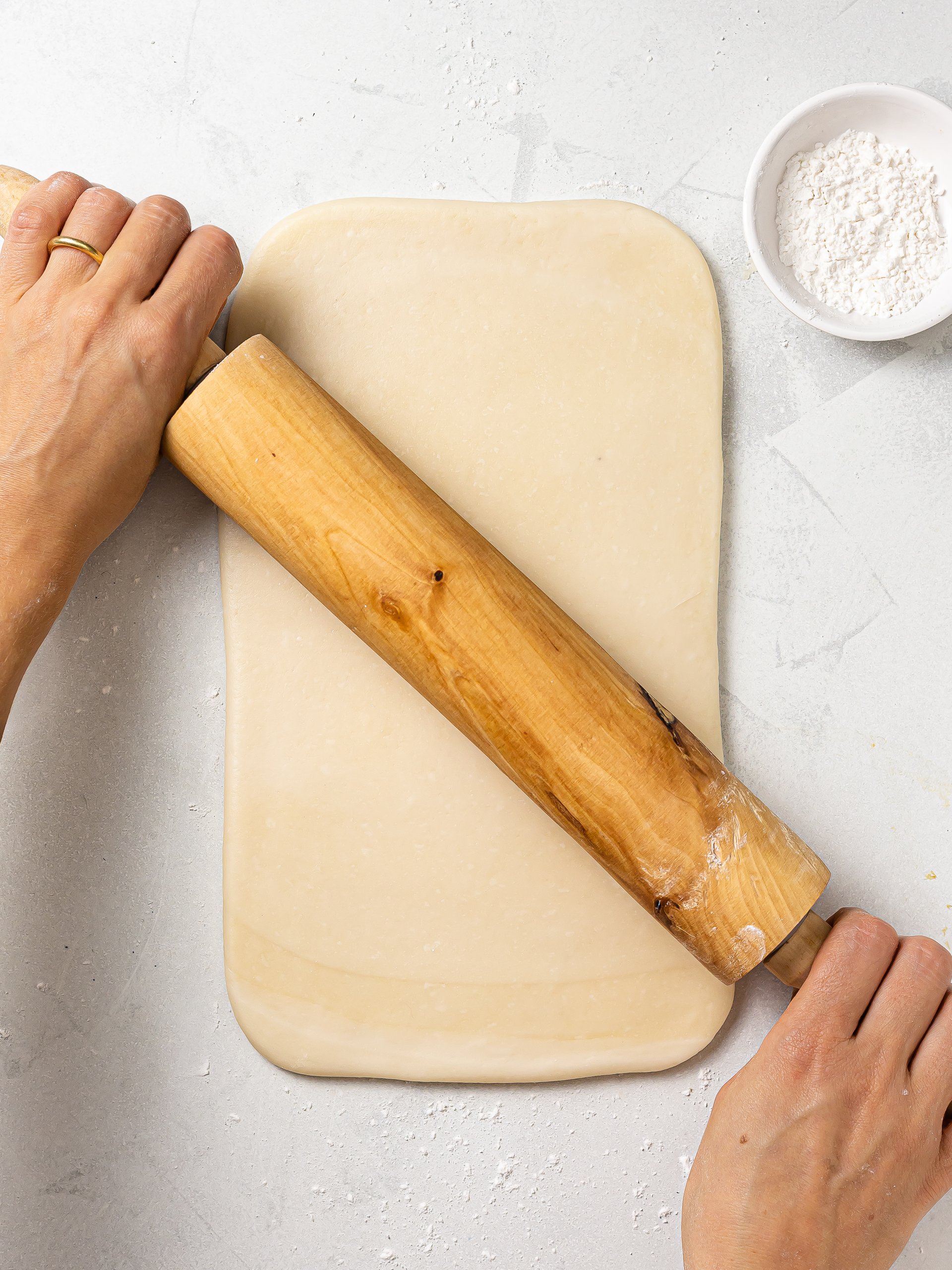
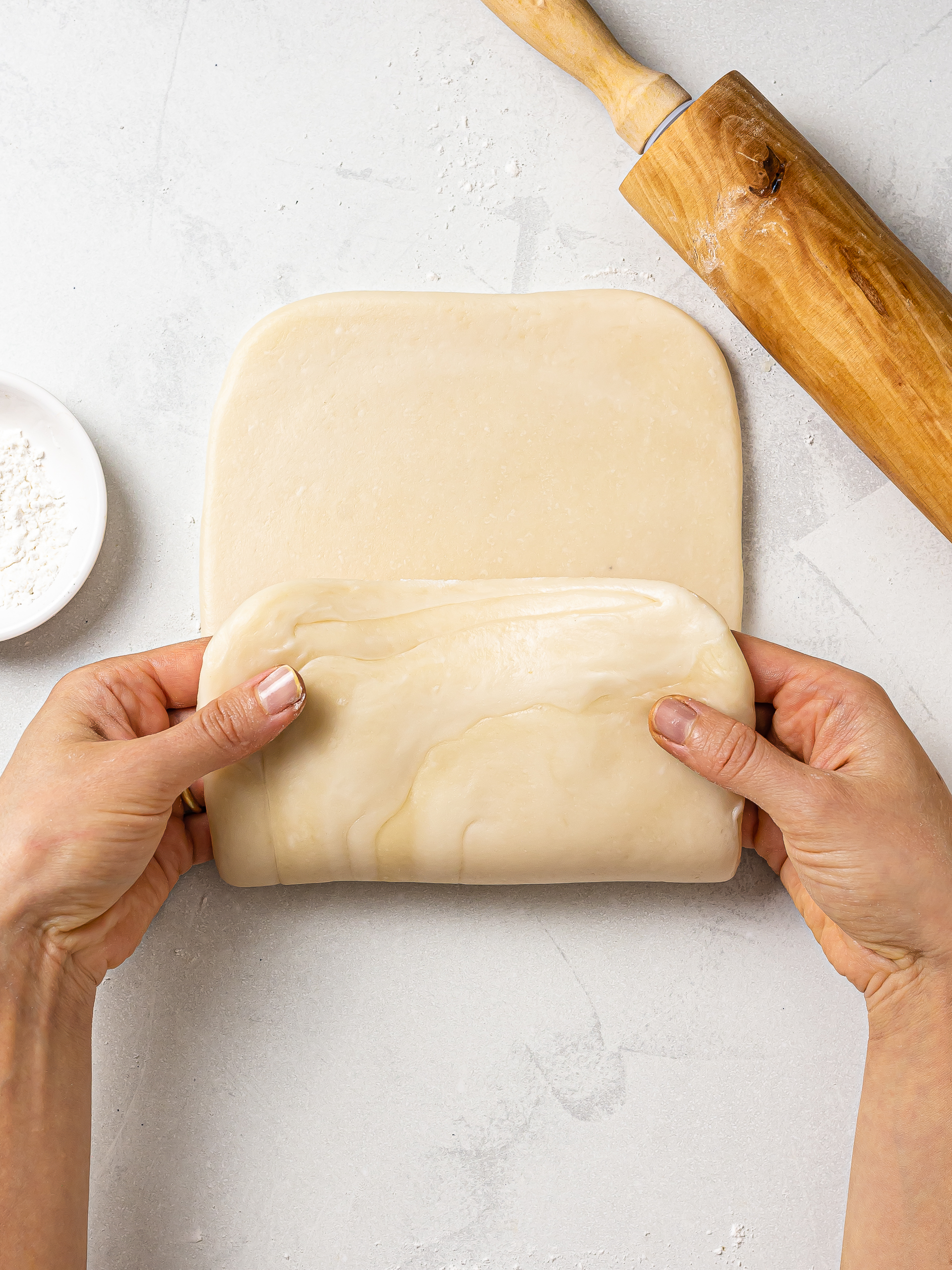
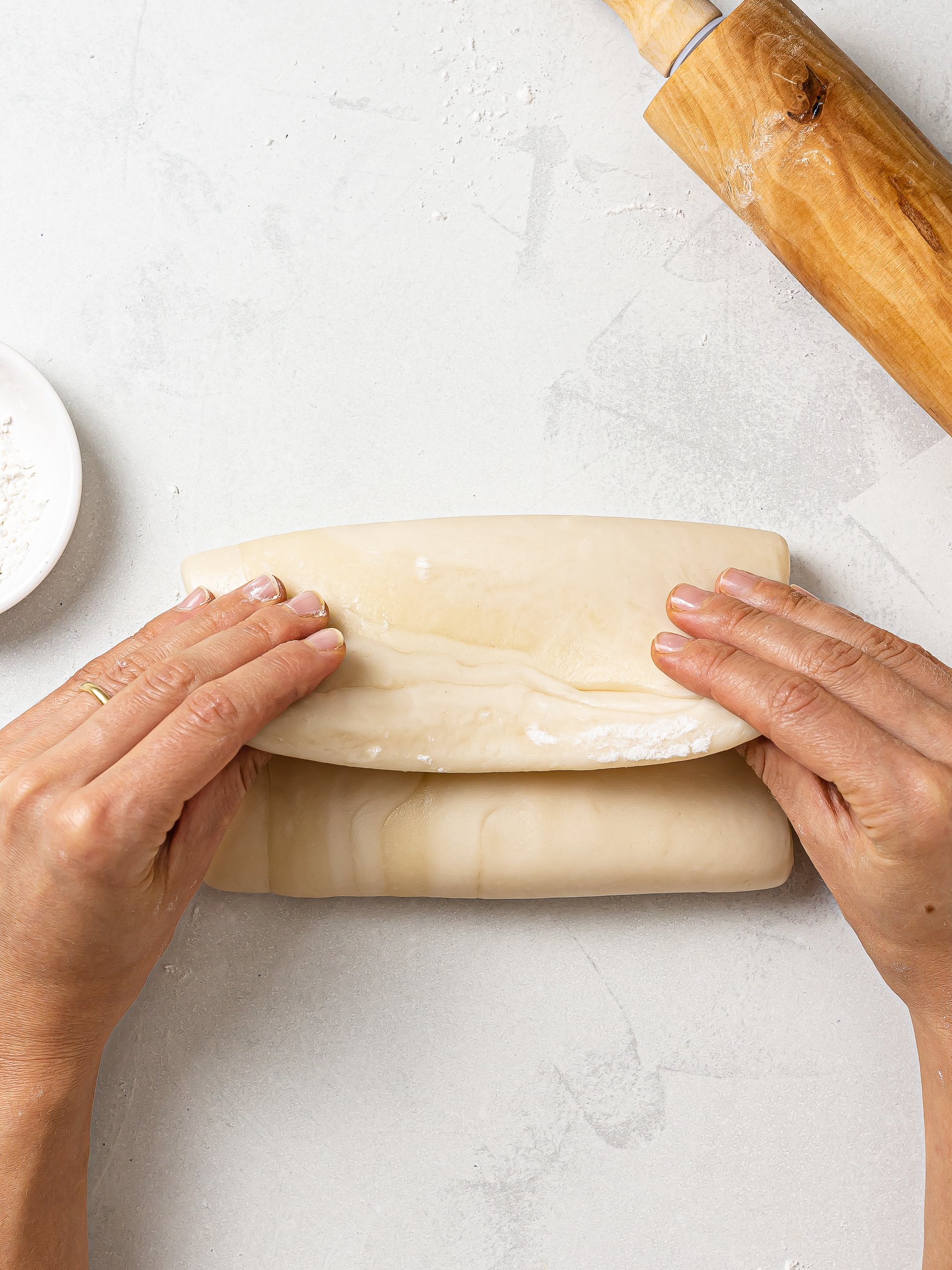
Step 8
Next, roll the dough to increase the lamination layers.
This is a quick way to get lots of layers without repeating the lamination too many times.
To do it, unwrap the dough and roll it out into a large rectangle, as thin as possible.
If the dough feels too stiff and recoils back, let it rest for a few minutes.
Start at the short end of the rectangle and roll the dough tightly into a log (1).
Then, press the log down with the rolling pin to flatten it (2) and roll the dough back into a rectangle.
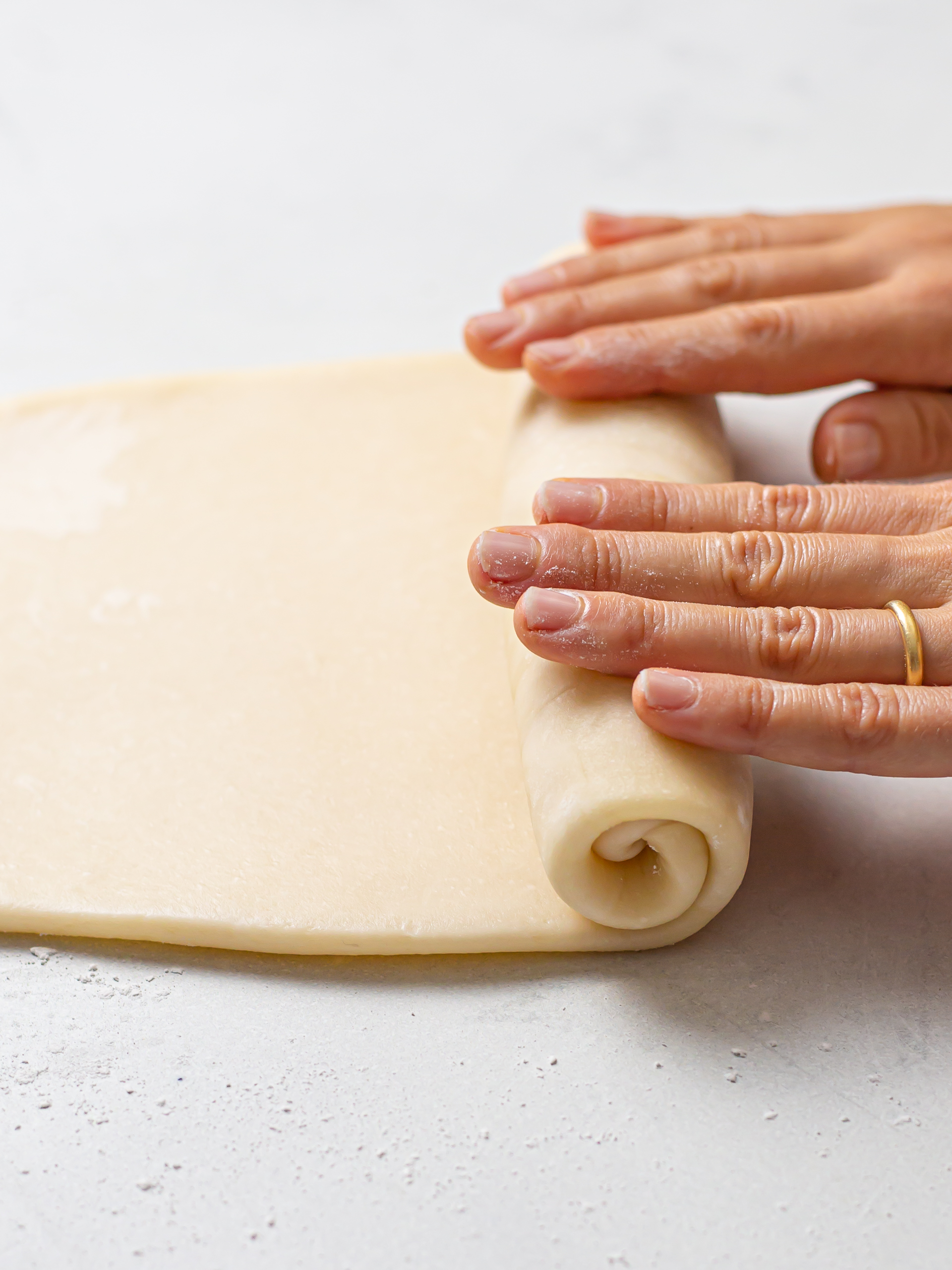
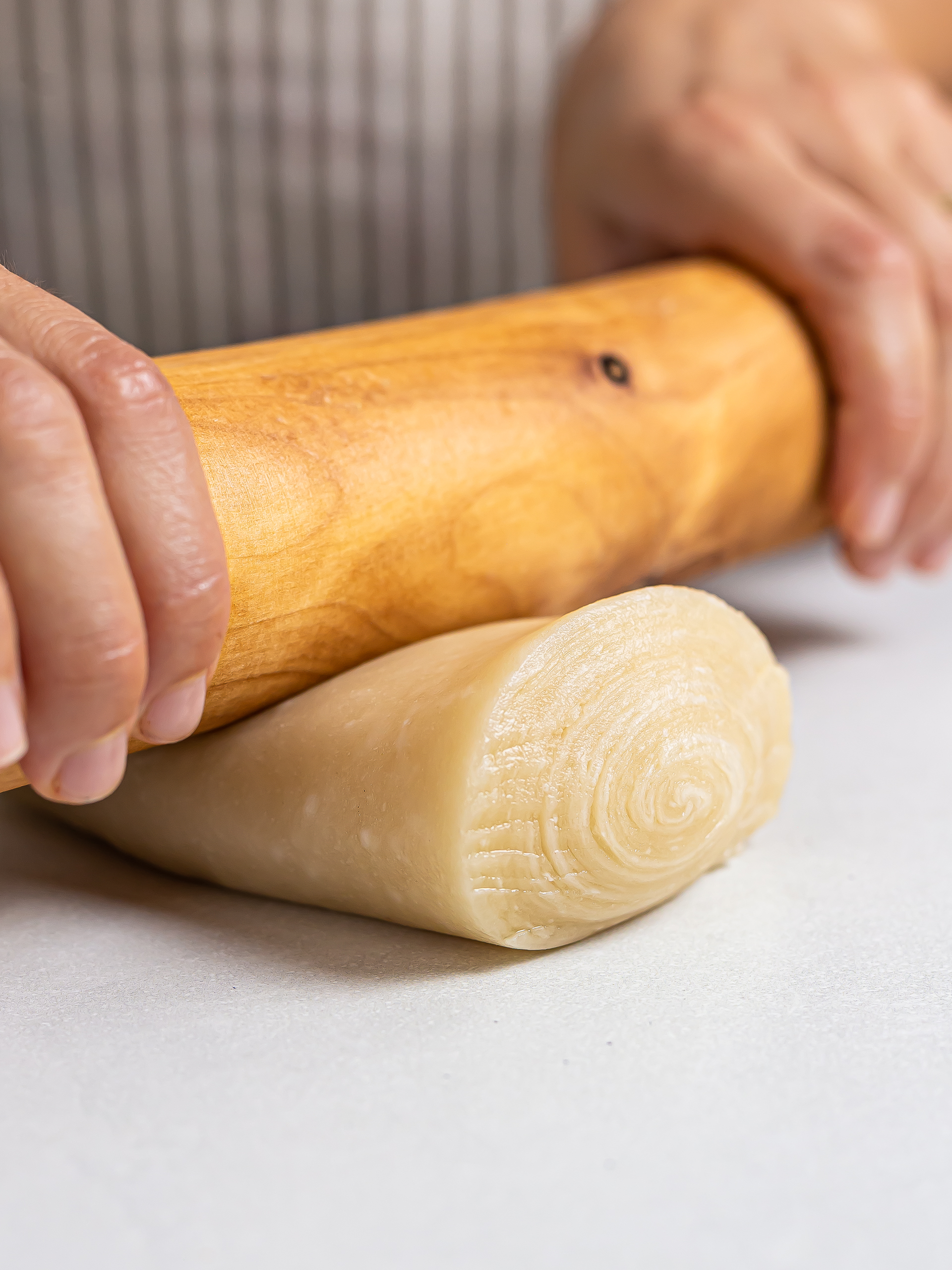
Step 9
Now, make the hopia dough wrappers.
Use a sharp knife or a pastry wheel cutter to cut thick squares of dough — as many as the number of servings (12 for the default ingredients).
Why squares and not circles, you ask? So that you don't have any leftovers to re-process!
Work with one square at a time, and keep the others in the fridge wrapped in cling film so they won't get too warm and oily.
Flatten each dough square into an 8-8.5 cm (3-3.5 inches) hopia wrapper, keeping the edges thinner than the centre, as shown in the picture.
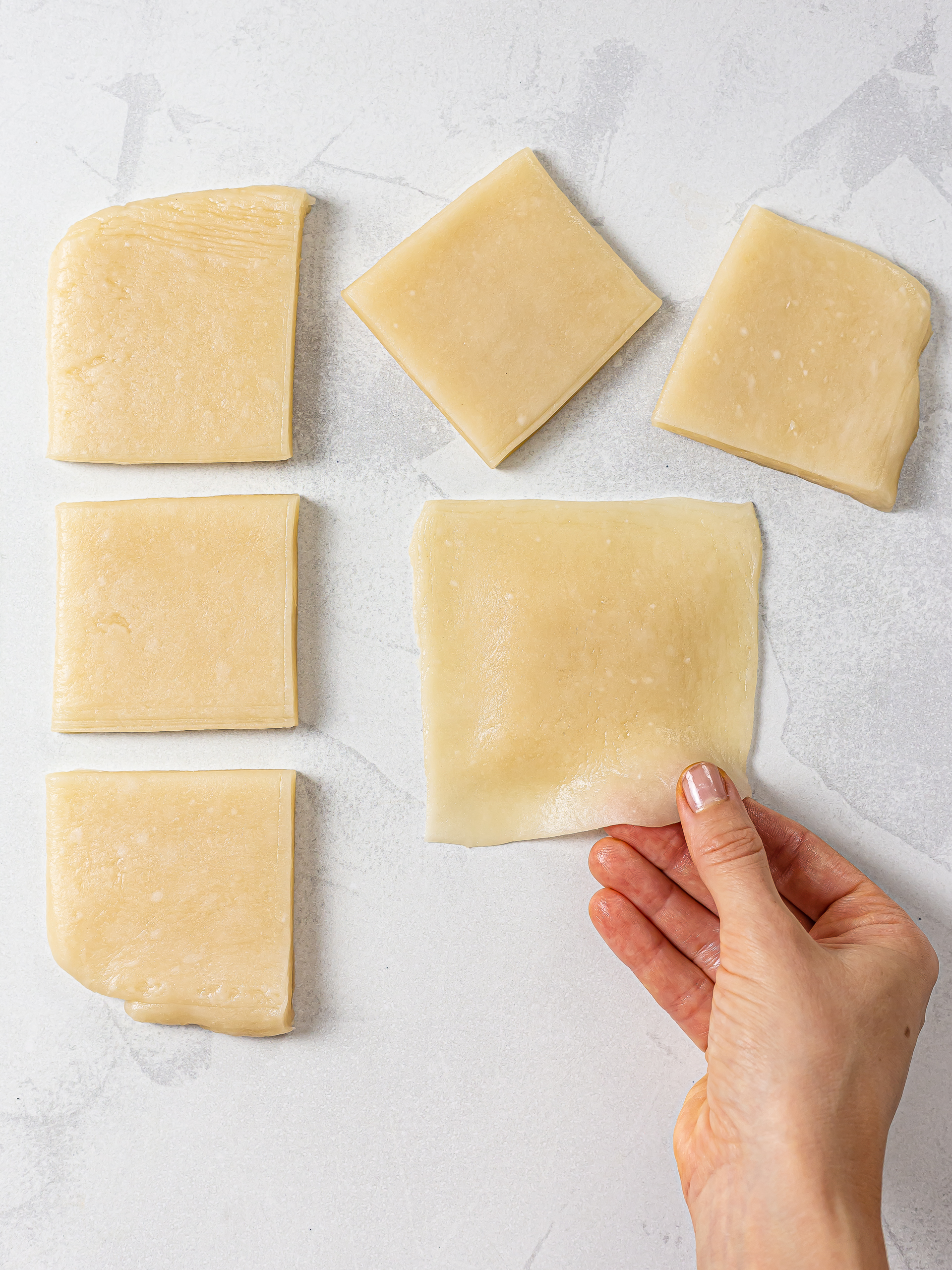
Step 10
Next, fill and seal the hopia cakes.
Portion the sweet mung bean paste into 28g (1 oz) balls.
Place one ball in the centre of one pastry dough wrapper (1).
Fold two opposite sides of the dough wrapper over the mung bean filling, then the other two sides, and finally fold any dough creases toward the centre.
Press and pinch the dough at the top to seal the hopia as you would do to close a dumpling (2).
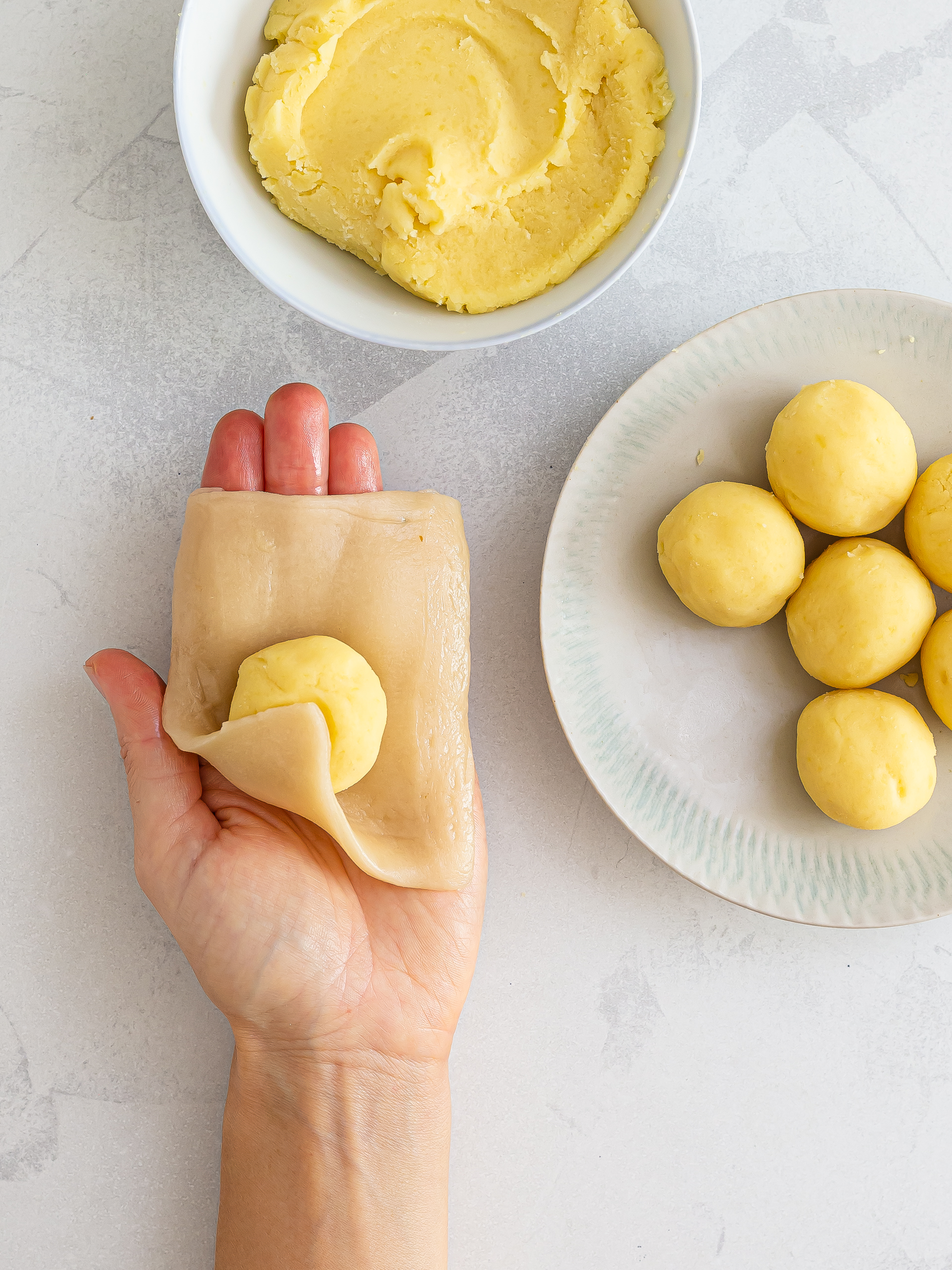
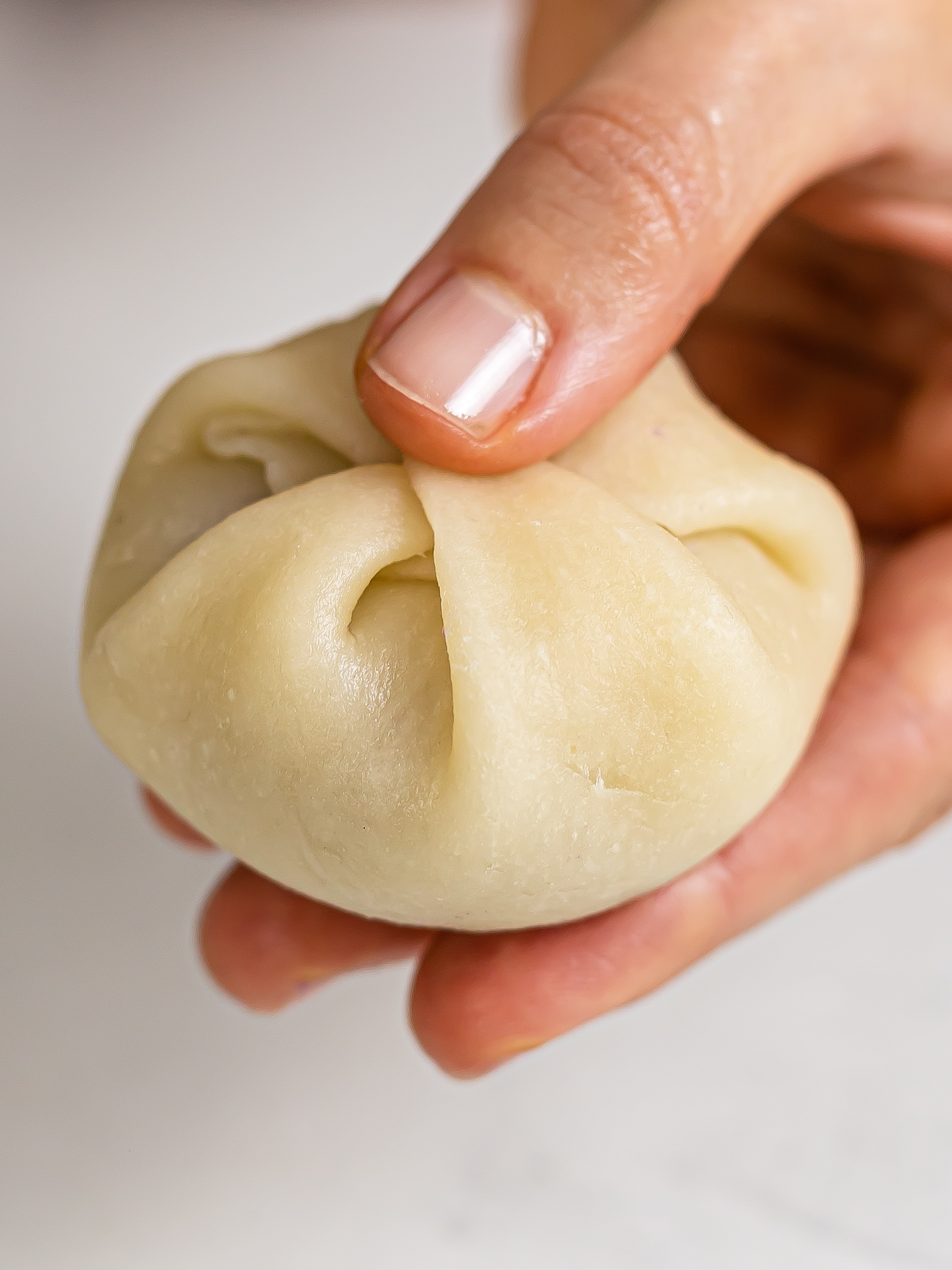
Step 11
To shape the munggo hopia like a dome, slot the hopia seam-side-up into a small measuring cup lined with cling film.
We used a 1/4 of a cup measuring cup, but you can also use a small cookie cutter or anything small and round.
Firmly press the hopia down into the cup to mould it and also to seal and secure the seam (1).
Then, pull the cling film to pop the hopia cake out of the cup and flip it (2).
Ensure the hopia is well sealed and the dough has no holes.
Repeat steps 9 to 11 until you have used all the hopia pastry dough and yellow mung bean filling.
If you have any leftover bean paste, you can use it to make these healthy mung bean popsicles!
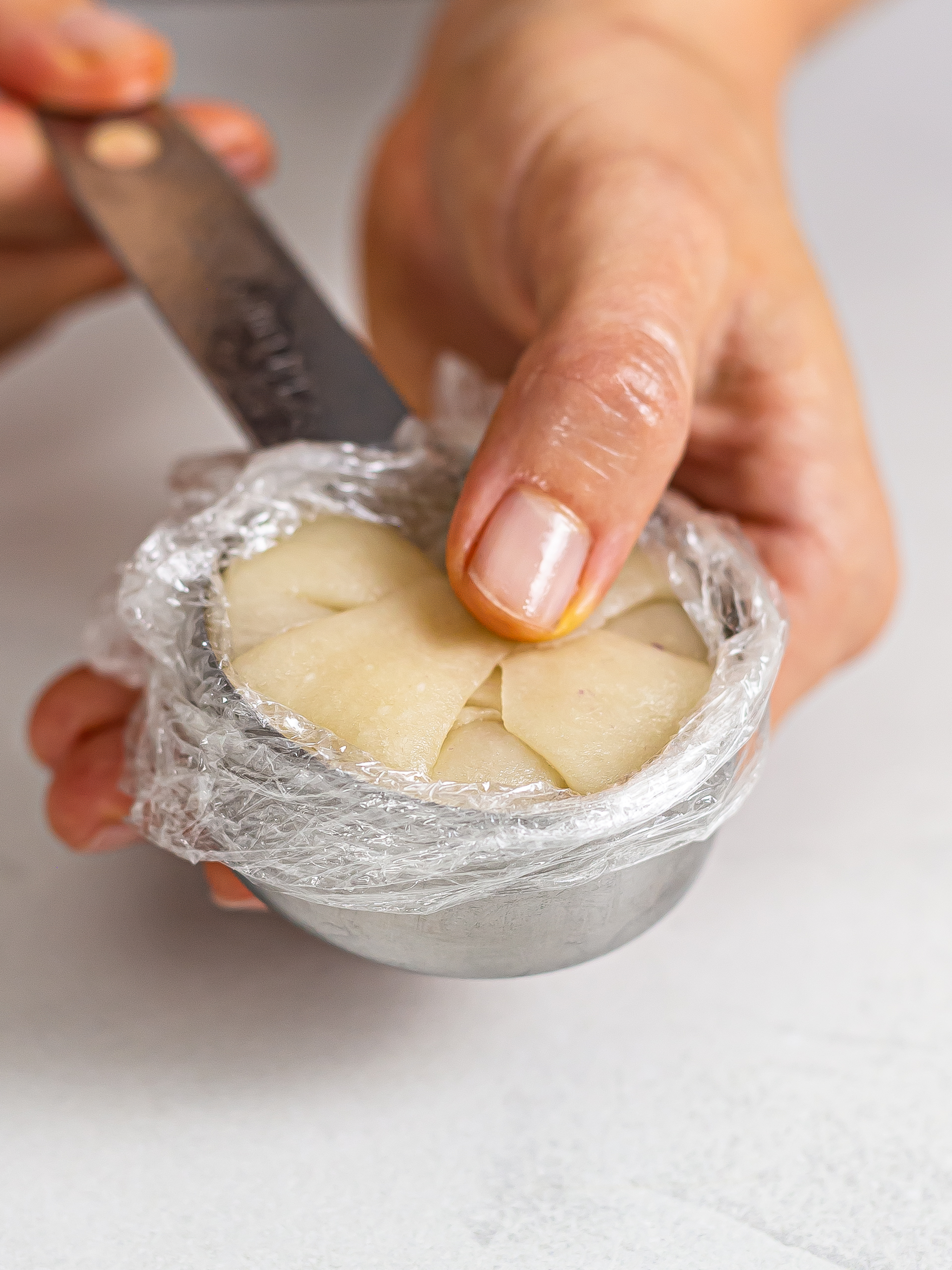
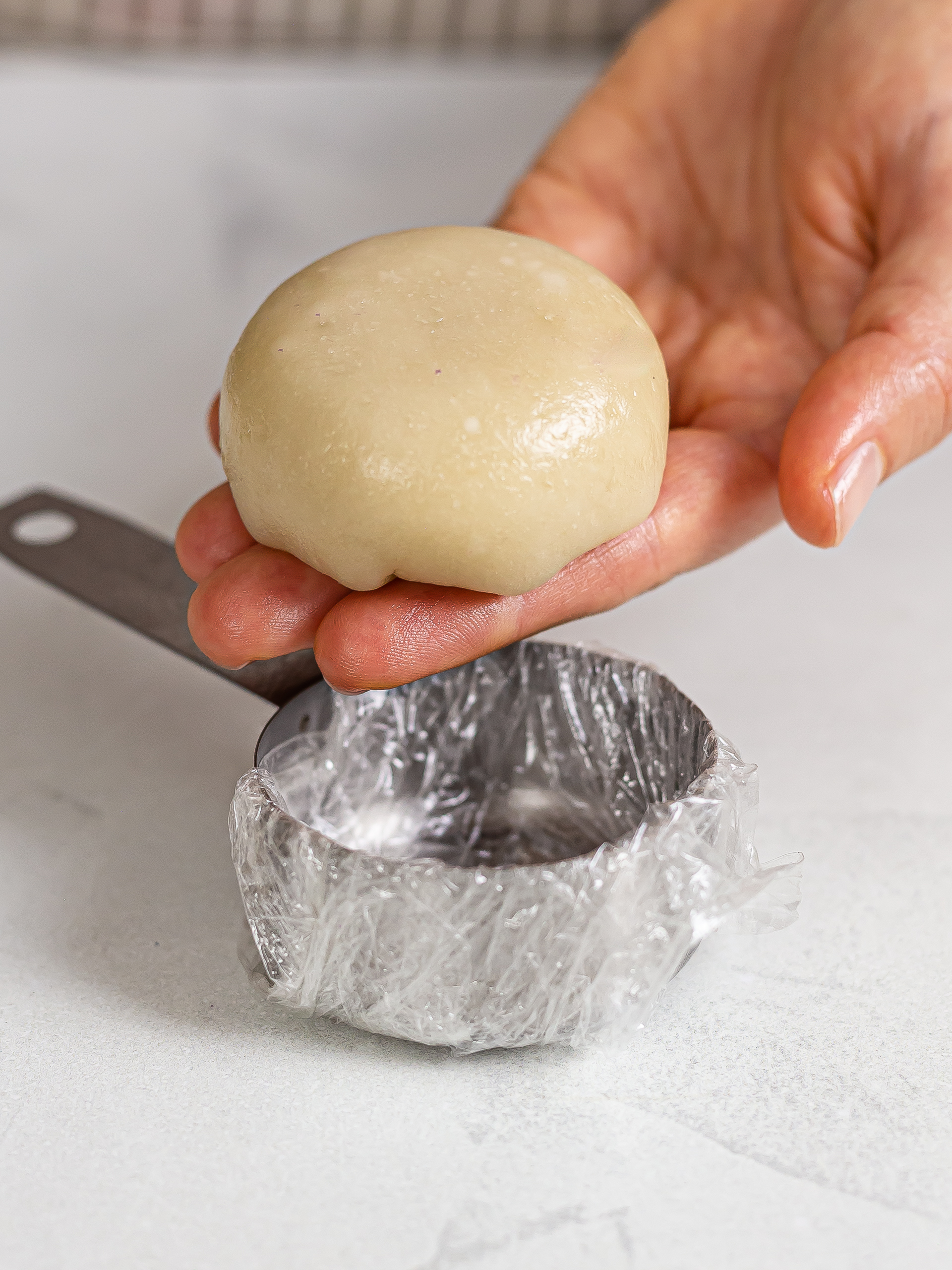
Step 12
Next, bake the mung bean-filled hopia cakes.
Preheat the oven to 190°C (375°F) and line a baking tray with parchment paper.
Place the hopia cakes onto the prepared tray, seam side up.
Bake them for 15-20 minutes or until the bottom is lightly golden.
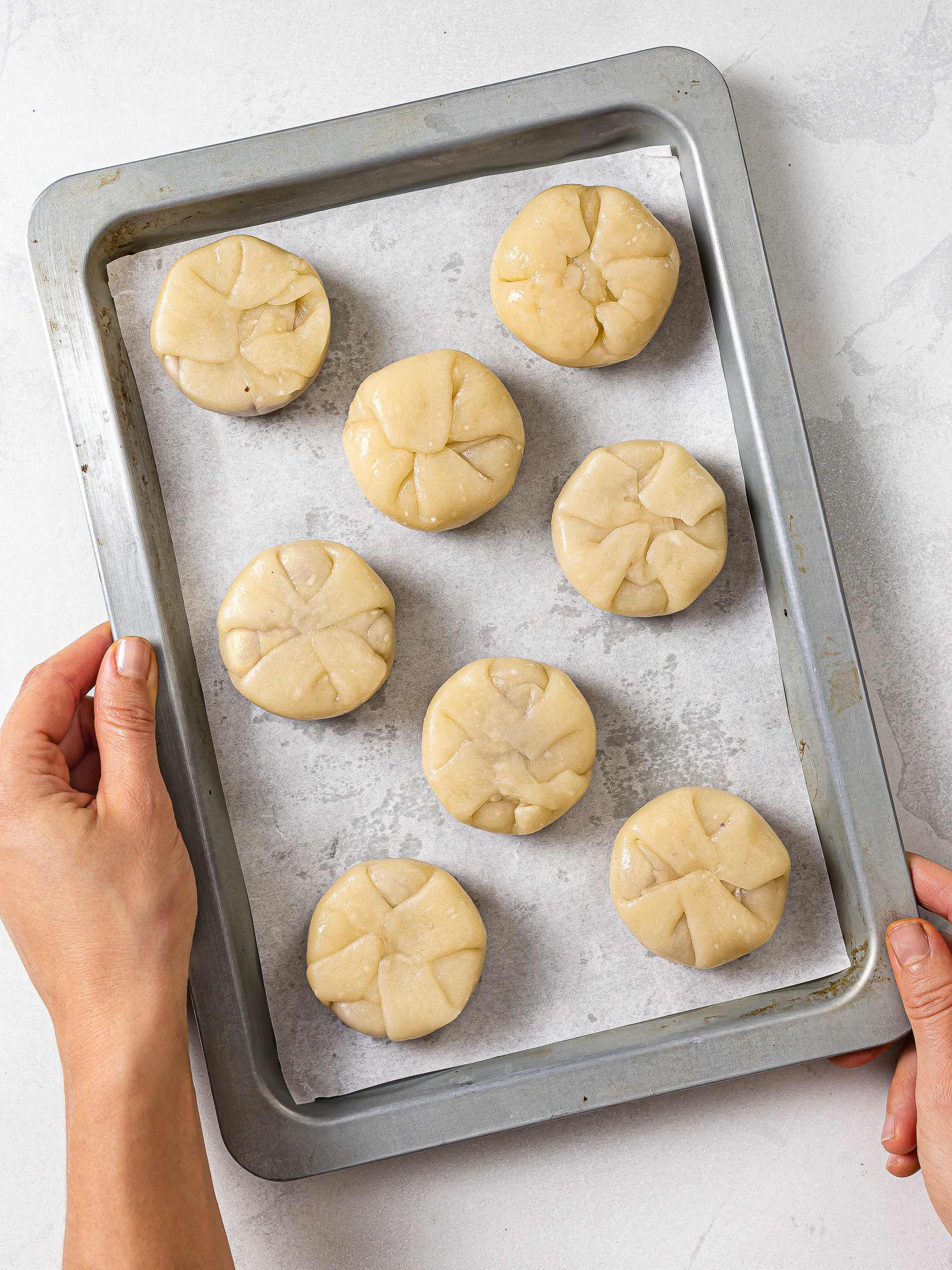
Step 13
Then, take the tray out of the oven and carefully flip the hopia so the seam faces down.
Gently press the top of the pastries with a spatula to flatten them.
At this point, you can optionally brush the hopia for a golden finish; check our tips below on how to do it.
Return the hopia cakes to the oven and bake them for 15 more minutes or until they're golden and crusty.
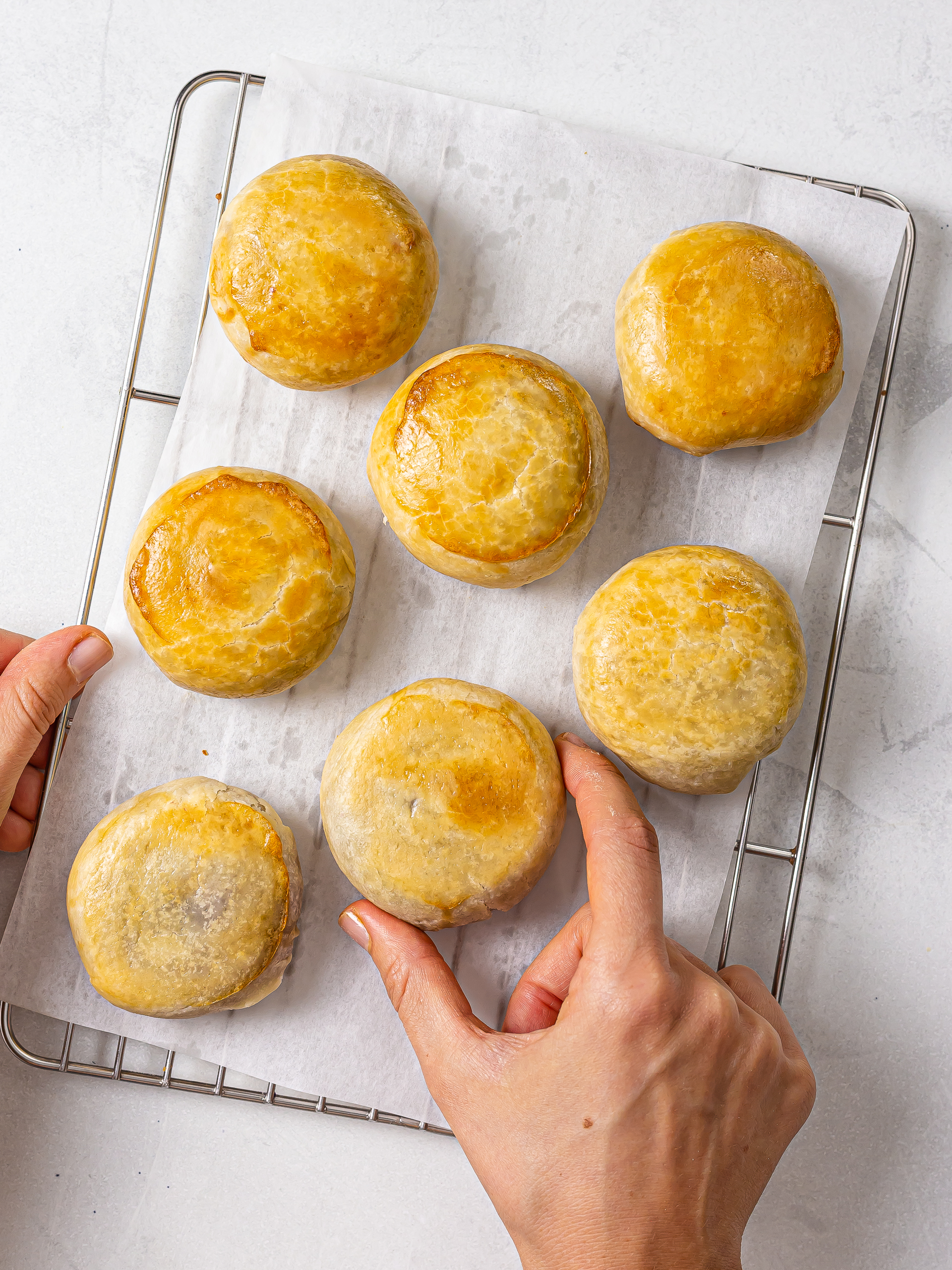
Step 14
Your homemade Filipino munggo hopia pastries are ready!
Serve them warm or cold, and enjoy them with a cup of green tea or a tall glass of iced tea, like this lychee iced tea!
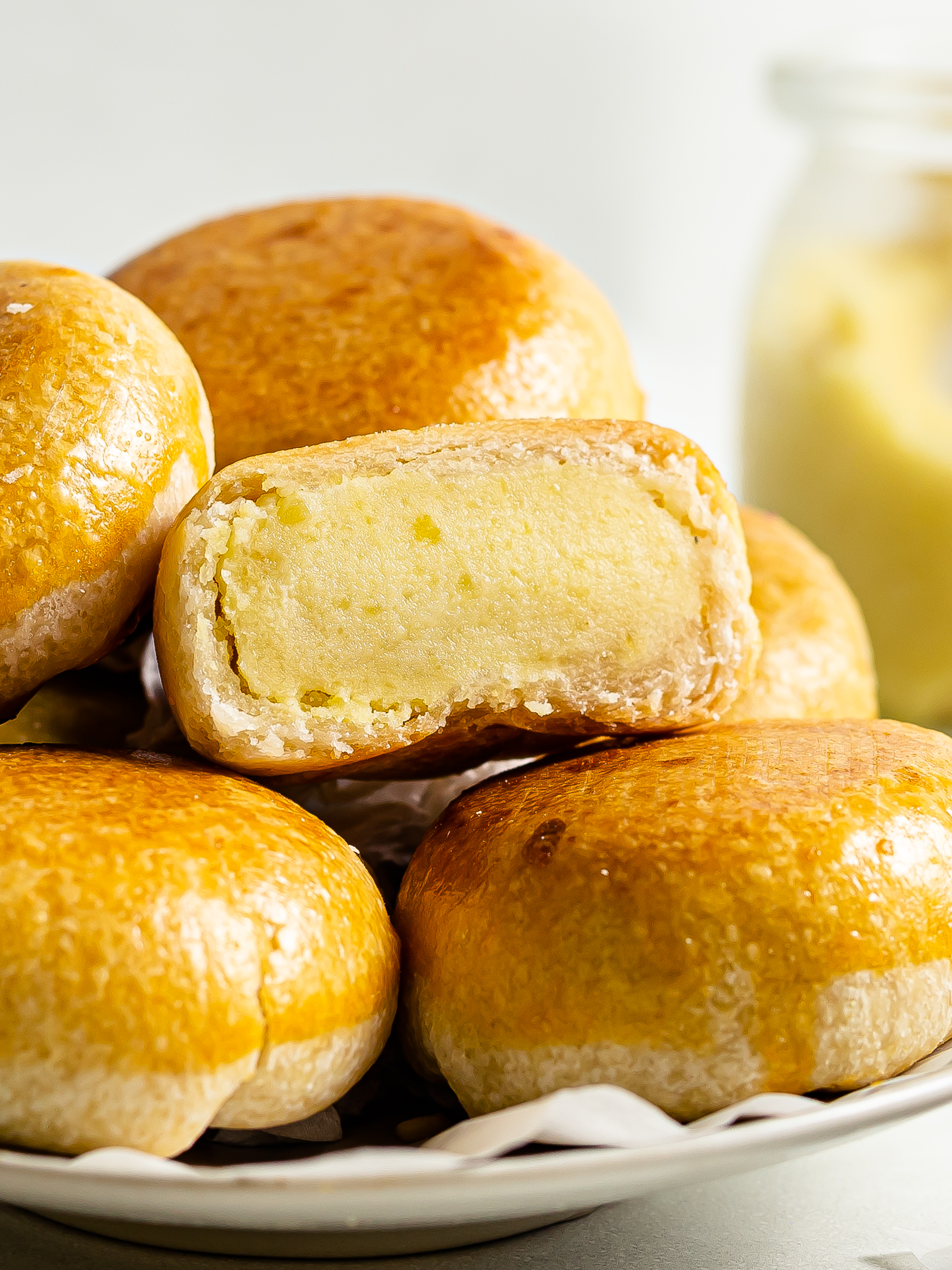
Tips
To make the mungo hopia cakes look golden and glossy, you can brush them with:
Eggwash (one egg beaten with one tablespoon of water)
Egg Yolks (one egg yolk beaten with 1/2 tablespoon of water for a glossier finish)
A mix of oil + maple syrup/honey + soy milk (1:1:1 ratios) for an egg-free alternative
After you have laminated the dough, you can freeze it and keep it for another time. You can also freeze the munggo hopia, either before or after baking. You can find more tips on how to freeze hopia cakes in our ube hopia recipe.
